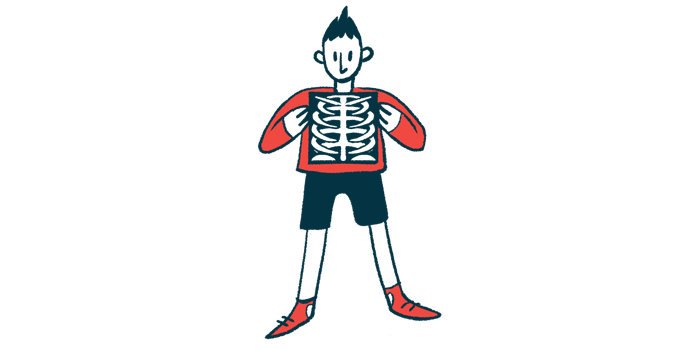Rare, Destructive Andersson Lesion Found in Man, 79, With AS: Report
Possible 1st documented case of infected spinal lesion with severe paralysis
Written by |

Researchers are reporting the rare case of an Andersson lesion — a destructive spinal lesion without history of trauma — in a 79-year-old man in Greece with undiagnosed ankylosing spondylitis (AS).
Rarer still, the lesion likely was caused by an infection and partial paralysis.
This case is believed to be the second documentation of an infected Andersson lesion in AS, but the first with severe paralysis, the researchers noted.
According to the team, “at the 18-month follow-up our patient had significant improvement of [his] functional status.”
The case study, “An infected Andersson lesion presented with incomplete paraplegia in a patient with ankylosing spondylitis. A unique case report with literature review,” was published in Spinal Cord Series and Cases.
AS is an inflammatory disease that causes arthritis mainly in the spine and sacroiliac joints, where the base of the spine meets the pelvis. It may lead to abnormal bone growth and fusion between vertebral discs that causes the spine to become rigid.
AS signs and symptoms
This results in low bone density, susceptibility to injuries, and a “bamboo” spine, in which the backbones have fused, forming one long bone.
Andersson’s lesion, characterized by a destruction of the vertebras or the discs that sit between them without a history of trauma, is a rare complication of AS. It was first described in 1937.
In patients, the lesion leads to back pain, numbness, tingling, and weakness in the lower body.
Its exact frequency “is currently unknown and ranges from 1.5% to over 28%,” the researchers wrote.
The underlying cause of Andersson lesions also is unknown, but scientists believe they “may result from inflammation or stress fracture of the rigid spine, while there is no evidence for an infectious origin,” the team wrote.
Only one previous study has reported the case of an infected Andersson lesion.
Now, researchers at the General Hospital of Patras Spine and Trauma Unit, in Greece, described the rare case of an Andersson lesion likely caused by an infection and partial paralysis in an elderly man.
The man was admitted to the emergency department due to his inability to bear weight or stand, without any history of trauma. His medical history showed he was clinically obese, and had an enlarged prostate, as well as arthritis of the hip and knee joints.
In the week before his admission, the man had experienced severe pain on his right knee and inability to move it. A private orthopedic surgeon treated him with hyaluronic acid injections directly into the knee joint, steroids, and paracetamol, but he did not get relief.
At examination in the emergency department, he showed sensory loss in his mid-back and no movement in either leg. Blood tests indicated evidence of inflammation and active infection.
His liver function was normal, but his blood sugar levels were abnormally elevated, and he was diagnosed with type 2 diabetes.
Imaging scans of his back showed the classic bamboo spine seen in AS, as well as a severe lesion in a joint and vertebra in his lower-middle back. The lesion was initially classified as a trauma-caused fracture.
Based on his medical history, imaging scans, and clinical examinations, the doctors performed a blood test for HLA-B27, a marker of inflammatory arthritis of the spine and joints. Its presence confirmed an AS diagnosis, and the fracture was reclassified as an Andersson lesion.
Surgery results
Because of his unstable spine and partial paralysis, the man underwent surgery to relieve compressed nerves in the spine, and spinal stabilization with metal screws. The presence of pus in the affected vertebra was noted during the surgery, so all infected tissue was removed and then later analyzed.
Those analyses revealed infection with the bacteria Enterococus, which also was present in the patient’s urine.
The man was treated with antibiotics, given directly into the bloodstream, for four weeks until there were no signs of infection. This was followed by oral antibiotics for three months. He then was transferred to a rehabilitation center for further care.
“At the eighteen-months follow-up and just three months after the discharge from the rehabilitation unit, our patient had significant improvement of his functional status. He could stand and walk some steps, with two walking sticks, [and] he had minor sensory deficits,” the researchers wrote.
Although he had numbness in his feet and most of his leg muscles, further imaging scans showed adequate fusion of his vertebrae and no signs of infection.
“We cannot be sure if infection was the cause of the AL, or the pathogen was spread from the urinary tract to the spine,” the team wrote.
The researchers noted that obesity, undiagnosed diabetes, and continuous wrong treatment with steroids for hip and knee arthritis likely contributed to the spinal infection.
“Spine surgeons should be able to recognize AS and the Andersson lesion and properly consult patients to receive rheumatologic consultation. They should also be competent to differentiate the [trauma-induced] fracture from the Andersson lesion,” the researchers wrote.
“We suggest spine surgeons to obtain [tissue samples during surgery] in cases with Andersson lesions, to exclude the minor possibility of the infectious origin of the entity and/or the possible secondary contamination of the affected area,” they added.







